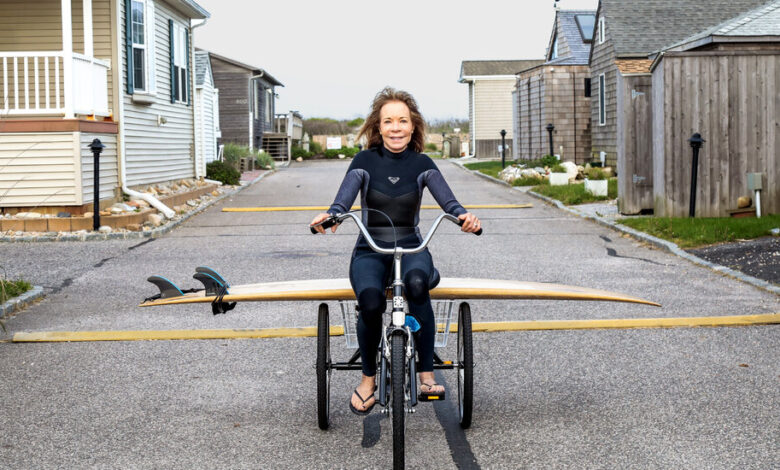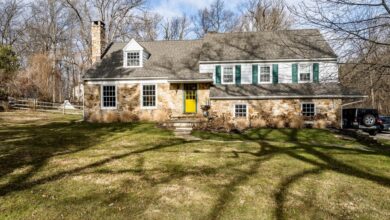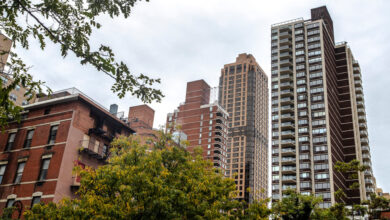Inside Montauk’s Luxurious ‘Trailer Park’

[ad_1]
On a recent May evening, Janet O’Brien served up Old-Fashioneds and tequilas on ice to friends at her Montauk home. The conversational menu featured what one might expect for a tony Hamptons cocktail hour: past and upcoming trips to Morocco, Manhattanites bragging about rarely stepping foot in Brooklyn and gossip about how much neighbors spent on renovations.
The setting is perhaps the interesting part: Ms. O’Brien’s home is in what they all call “a trailer park.”
Montauk Shores, the roughly 200-unit manufactured home community that overlooks Ditch Plains Beach, isn’t what immediately comes to mind when one thinks of a trailer park. The crash of ocean waves pierces the air, and nearly everything in the park looks to be in pristine condition — including the manicured lawns, the smoothly paved roads and the “trailers.”
For many people, living in a manufactured home isn’t a choice, but a necessity. Here, the “trailers” are several people’s second or third homes, and often not their only home in the Hamptons. A pied-à-terre for a pied-à-terre.
The average price of a single-section manufactured home in the United States is $86,100, according to the Manufactured Housing Institute trade organization. But that won’t get you much in Montauk Shores, where an 800-square-foot beachfront home sold for $3.75 million in February, the highest recorded sale in the park’s history.
A million-dollar trailer park isn’t unheard of — take, for example, Paradise Cove Mobile Home Park in Malibu or Smuggler Park in Aspen. The luxury communities were generally formed as something very different. Montauk Shores began as a campsite, and in the 1970s, it officially became a mobile home condominium.
In its early days, fully-furnished trailers typically went for $10,000. It was an affordable place for blue-collar workers and families to enjoy a slice of beachy Hamptons life, a refuge for those who might not otherwise have had one. “A lot of the people there were firemen and policemen. It was just a place for them to escape,” said Tom Zemaitis, 73, who at first knew of Montauk Shores as a campground and purchased a trailer with his wife, Cherie Doughan, in 1976. “We loved going to Montauk, but it’s changed.”
The homes have gotten bigger and glitzier. Driveways are now lined with BMWs and Mercedes-Benzes. At one point, J. Darius Bikoff, the founder of Vitamin Water, bought a home there.
Ms. O’Brien, the founder and president of an events and catering company, owns three homes: her main residence in Sag Harbor, a winter hide-out in Snowmass, Colo., and her home not far away from home at Montauk Shores.
To snag her spot in Montauk Shores in 2005, she famously got into a bidding war with Jimmy Buffett for a beachfront unit. The owner accepted her $430,000 offer, and the two also bonded over their shared Irish heritage, Ms. O’Brien said. In 2020, she sold that home for nearly $1.4 million and used the money to buy another home in the park for $725,000.
Ms. O’Brien’s current two-bedroom manufactured home has a deck, outdoor shower and an all-white interior — including white furniture, pillows, appliances and décor. The bleached design choice is meant to serve as a counter to her otherwise stressful life, said Ms. O’Brien, 52.
“I just knew it — that I wanted to have a spot there, from just being in there and being on the beach,” said Ms. O’Brien, who rents out her unit to tenants during peak summer months. “I put my surfboard across the back of my tricycle and bungee cord it and ride down to the gate. Going over the speed bumps, I’m as happy as can be.”
Looking for Something That ‘Rarely Exists’
When a unit in Montauk Shores went up for sale in 2014, Louise Phillips Forbes knew she had to act fast.
She put in an offer sight unseen, and bought the property for around $570,000.
“Boy, when we got there, it was not very pretty,” said Ms. Forbes, 60, a real estate broker. “I wouldn’t even walk inside it. I just bought it. There was a tree growing through the ground inside the house.”
Ms. Forbes and her husband tore it down and replaced it with a two-bedroom, 900-square-foot abode, complete with hand-drawn wallpaper adorned with waves and a granite kitchen countertop installed upside down. (Ms. Forbes preferred the matte finish to the glossiness of the top.)
“I love saying that I’m trailer trash just because I like to see how people will respond. But honestly, it would technically be a prefab house,” Ms. Forbes said. Her primary residence is on the Upper West Side of Manhattan, and she also has a place in Bridgehampton.
Montauk Shores is reserved mostly for family time and surfing. “It’s about rolling out of bed and waxing your board and getting surf lessons,” she said. “The kids would run around in a herd. They had this freedom that you can’t have when you’re a city kid.”
Similarly, Alicia Murphy, an interior designer, said that the main appeal for buying into Montauk Shores was for the enjoyment of her four children.
“We’re giving our kids that kind of old-school, American, community-based summer that really rarely exists anymore,” said Ms. Murphy, 37, who lives full-time in nearby Amagansett. “I think that’s why all these wealthy people are buying these houses, because they want to give their kids and their family that laid-back summer at the beach in a little 800-square-foot shack.”
When Ms. Murphy and her husband first bought the property in 2013, it was a “somewhat rundown single-wide.” It had shag carpeting, an avocado green kitchen and mirrored walls, Ms. Murphy said. “I walked in one time and said, ‘I can’t be in here,’ and I walked out.”
They replaced it with a custom-designed manufactured residence that has a 14-foot-high pitched ceiling, a shower with a skylight and a deck. Because the cost of labor was more expensive in Montauk, Ms. Murphy said that she worked with a manufacturer out of state to install various features. “I ordered the kitchen, I sent it to Indiana. We ordered the windows, we sent them to Indiana. I ordered tiles from Southampton and sent them to Indiana.”
Dirt Roads, Tents and Cold Water
Mr. Zemaitis and Ms. Doughan, who now live in Placida, Fla., fondly remember what Montauk Shores used to be like. They’re both now retired — Ms. Doughan worked as physical therapist and Mr. Zemaitis was an information technology consultant (after gigs performing in a rock band and working at a music store).
“There were parties going on all the time. We had a tequila party,” said Ms. Doughan, 73. The couple would drive in for long weekends from their apartment in Kips Bay, Manhattan with their two cats — Bombay and Captain Morgan — who would get all excited as they neared the park. “They were so happy to be there because we’d let them out.”
The couple originally met at a nightclub in Montauk called the Cola Copa, and they had both grown up spending summers in the park. Ms. Doughan’s father, Al Doughan, played an integral role in the park’s formation. Functioning as a dealer, Mr. Doughan sold mobile home units to people for around $10,000. “He was trying to promote the community and make it easy for people to get the mobile homes,” Mr. Zemaitis said.
When it was mostly just tents in the 1960s, Mr. Zemaitis recalled, there were dirt roads and public restrooms with only cold water. He also remembered making lobster traps with park residents, and having to take over the barbecue almost every time Mr. Doughan put it on, because he would wander off to have a cocktail with a neighbor. “It would burn all the time,” Mr. Zemaitis said.
“Over the years, everything got more expensive,” he said. “When we went back to visit, we would buy stuff inland before we got to Montauk, because if you bought a pound of butter, it was like you had to take a mortgage out.” Around 1990, the couple sold their trailer for $45,000.
There are a handful of original owners remaining in the park today, including Mr. Zemaitis’s brother. Thinking about all the ways in which it has changed over the years, “it makes me sad,” Ms. Doughan said. “I grew up with everyone there.”
‘Money to Burn’
Present day in Montauk Shores, the meaning of living in a trailer park, for many of the current residents, has shifted far from the original intention of manufactured homes. In the 1980s, around the time of the park’s official founding, manufactured homes were the fastest-growing type of residence in the country, proliferating as a solution to the nation’s high housing costs. In 1992, The Times reported that nearly 16 million Americans, or about 1 in 16, lived in them.
Today, an estimated 22 million American residents live in manufactured homes, according to the Manufactured Housing Institute trade organization. In recent years, the affordable housing stock that manufactured homes represent has been increasingly threatened, with investors being responsible for increasing shares of mobile home park purchases.
At least one aspect of life in Montauk Shores might have remained constant over time. Several owners — past and present — stressed that they felt a strong sense of camaraderie with their neighbors. The homes are situated close together, so the park naturally lends itself toward a kind of communal living. It also hosts arts and crafts activities for children, bingo nights and pancake breakfasts.
But at times, there has been some tension between the newer owners and the ones who’ve been there longer, Ms. O’Brien said. She recalled getting fined for minor violations over the years, including for having noisy tenants. “A lot of the old guard here were complaining about the surfers,” she said. “Anyway, we’re kind of taking over, slowly and surely.”
Walking by her old oceanfront home, Ms. O’Brien pointed out the various owners who had multiple properties in the park. “They bought this one, and I think they bought another one. I mean, there’s people with money to burn.”
If the waves are good for surfing, Ms. O’Brien said, some owners just come out and use their units as changing rooms. She added, “I’m kind of the same.”
For some, caught between nostalgia for the past and the realities of the present, living in Montauk Shores feels conflicting.
Andrea Tese, 40, began renting a home in the park about a decade ago. A restaurateur and fisher, she spends much of her time there spear and fly fishing — it’s too crowded to enjoy surfing, Ms. Tese added. “It’s a lot more flashy now,” she said. “There used to be a more relaxed, kind of old-timey feeling. Just a different sort of person was in the trailer park, like a retired cop.”
“I loved the way it was,” said Ms. Tese. “But I guess I’m also part of the change, right? So I can’t really complain.”
[ad_2]
Source link






